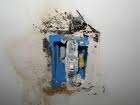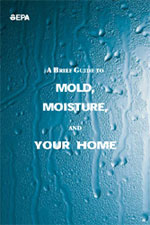





 Mold spores are all around us, but mold growth can be prevented. Mold Grows when the following conditions are present for more than 48 hours:
Mold spores are all around us, but mold growth can be prevented. Mold Grows when the following conditions are present for more than 48 hours:
- Moisture
- Warmth (Prefers temperatures between 40 and 100 degrees Fahrenheit)
- Food (dust, paper, wood, cloth, and other cellular types of materials)
 Mold is always present, but only grows when these conditions are present. Depriving mold of any of these environmental conditions will stop it from growing. Mold spores will remain dormant, and if the moisture, warmth and food all reappear, mold will begin to grow again. You don't kill Mold, you only remove it. You can have as many mold spores outside as you have inside. Mold spores are never going to go away, but need to be controlled.
Mold is always present, but only grows when these conditions are present. Depriving mold of any of these environmental conditions will stop it from growing. Mold spores will remain dormant, and if the moisture, warmth and food all reappear, mold will begin to grow again. You don't kill Mold, you only remove it. You can have as many mold spores outside as you have inside. Mold spores are never going to go away, but need to be controlled.
You should be aware of the following:
- Visible growth can spread
- Mold stays as a spore until certain conditions are present and then they grow into visible mold. After it gets the food it needs, mold can move to virtually any type of surface
- Once you determine the level of mold in your home or building, there are no standards for judging if the level could cause problems for the occupants. There is also no standard for measuring if a premises is clean
How do I know I have Mold?
- A musty or earthy odor
- Visible growth (discolored or look as if it has smudges or blotches)

Are Certain Environments more Prone to Mold than Others?
- Areas that have had flooding
- Areas where leakage has occurred in roofing, pipes, or walls
- Windows
- Behind walls, underneath carpets, or in other hidden areas
Ok, I have Mold - Now What?
- Immediately address the issue
- Keep the indoor relative humidity between 40% and 60% (Use dehumidifier to achieve this)
- If needed - arrange for an on-site inspection and/or consultation
- If needed - have a sample of the mold analyzed
- Immediately consider cleanup options. Early Detection and treatment can stop the problem from growing and minimize cleanup and repair expenses.
- EPA Site: http://www.epa.gov/mold
What Can I Do to Prevent Mold?
- Vacuum and clean regularly to remove possible sources of mold growth. Pay special attention to bathrooms and other areas that are likely to generate a lot of moisture
- In areas that are susceptible to moisture, use area rugs or washable floor surfaces rather than wall-to-wall carpeting. If you use area rugs, launder them periodically
- Do not store materials such as paper, books, clothes, or other possible sources of food for mold in humid areas
- Repair water leaks in your roof, windows, or any other areas as soon as possible
- Clean refrigerator drip pans regularly according to the manufacturer's instructions. If your refrigerator and freezer doors do not seal properly, moisture can build up and mold can grow there. Remove any mold on the door gaskets and replace faulty gaskets
- Ensure that gutters and downspouts are clear of debris that may block the flow of water from the roof. Make sure the area under downspouts is properly graded so that rainwater from the roof flows away from the foundation. Splash blocks can help rainwater to flow in the proper direction. If necessary, extend the downspouts
- Ensure that other areas around the foundation are graded so that rainwater does not flow toward the foundation. Do not put gardens or plants too close to the foundation so that watering them could cause water to flow toward the building. If you water your lawn with a sprinkler, make sure the water does not hit the house or the area next to the foundation
- In the kitchen and bathroom, open windows or use exhaust fans when engaging in activities that produce moisture. Exhaust fans should be vented to the outdoors and not to an attic or crawl space. If you have a clothes dryer, make sure it is vented to the outdoors
- If you use a humidifier, make sure it does not produce an excessive amount of humidity. The ASHRAE recommends keeping your home or building between 40% and 60% relative humidity throughout the entire year
- If the house or building has a basement, consider using a dehumidifier there. The cool basement floor and walls can be a source of moisture build-up
- If the home or building has an attic, make sure it is properly insulated and ventilated
- If there is a crawl space, cover the soil in the crawl space with waterproof polyethylene plastic. If the crawl space is ventilated, close the vents in the summer and keep them open in the winter
- If the basement or crawl space has a problem, clean up affected areas as quickly as possible and take immediate steps to resolve the source of the problem

 For more information on Mold Remediation visit United States Environmental Protection Agency "Guide to Mold, Moisture and your Home" http://www.epa.gov/mold/moldguide.html
For more information on Mold Remediation visit United States Environmental Protection Agency "Guide to Mold, Moisture and your Home" http://www.epa.gov/mold/moldguide.html